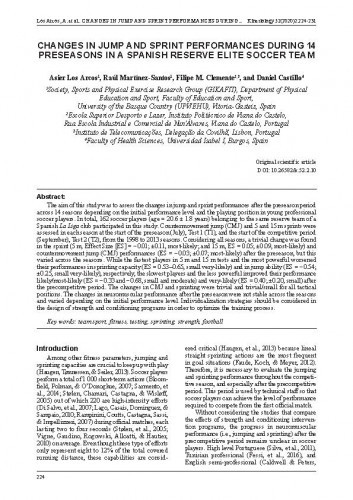The aim of this study was to assess the changes in jump and sprint performances after the preseason period across 14 seasons depending on the initial performance level and the playing position in young professional soccer players. In total, 162 soccer players (age = 20.6 ± 1.8 years) belonging to the same reserve team of a Spanish La Liga club participated in this study. Countermovement jump (CMJ) and 5 and 15 m sprints were assessed in each season at the start of the preseason (July), Test 1 (T1), and the start of the competitive period (September), Test 2 (T2), from the 1998 to 2013 seasons. Considering all seasons, a trivial change was found in the sprint (5 m, Effect Size [ES] = −0.01; ±0.11, most-likely; and 15 m, ES = 0.05; ±0.09, most-likely) and countermovement jump (CMJ) performances (ES = −0.03; ±0.07; most-likely) after the preseason, but this varied across the seasons. While the fastest players in 5 m and 15 m tests and the most powerful worsened their performances in sprinting capacity (ES = 0.53–0.65, small very-likely) and in jump ability (ES = −0.54; ±0.25, small very-likely), respectively, the slowest players and the less powerful improved their performance likely/most-likely (ES = −0.33 and −0.68, small and moderate) and very-likely (ES = 0.40; ±0.20, small) after the precompetitive period. The changes in CMJ and sprinting were trivial and trivial/small for all tactical positions. The changes in neuromuscular performance after the preseason were not stable across the seasons and varied depending on the initial performance level. Individualization strategies should be considered in the design of strength and conditioning programs in order to optimize the training process.
Sažetak

 Kinesiology : 51,2(2020) / editor-in-chief Dragan Milanović.
Kinesiology : 51,2(2020) / editor-in-chief Dragan Milanović.